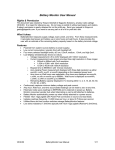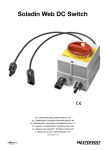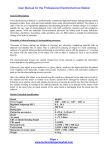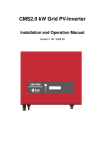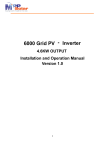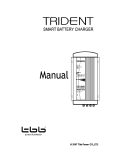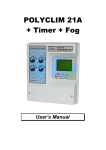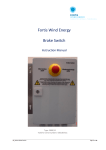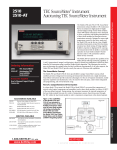Download PCM Solar King installation and user manual
Transcript
Grid PV-inverter 1500W/2000W/3000W/4000W/6000W Installation and Operation Manual 1 Only an electro-skilled person or trained assembly staff can install or open the Inverter. 2 Before you start… Thanks for purchasing Grid PV-Inverter. GRID PV-INVERTER is a highly reliable product due to innovative design and perfect quality control. This manual contains important information of installation, operation and safety reminding of this unit. Be sure to read this manual carefully before enjoying this product. If you encounter any problem during installing or running this unit, please check this manual first before contacting with your local dealer or representative. Most of the problems you encountered will be solved according to the instruction inside. Thank you for purchasing our product again. Please keep this manual in safe place for later use. 3 Safety instructions z 1. 2. 3. 4. 5. 6. Risk of Electric Shock Do not remove the covers. No user serviceable parts inside. Refer service to qualified service personnel. Both AC and DC voltage sources are terminated inside this equipment. Each circuit must be individually disconnected before servicing. When a photovoltaic array is exposed to light, it supplies a DC voltage to this equipment. Risk of electric shock from energy stored in capacitors. Do not remove cover until 3 hours after disconnecting all power sources. This unit is designed to feed power to grid (utility) only, do not connect this unit to AC power supplier. If connecting to those facilities, AC power supplier will be damaged. Please take out the unit from packaging box carefully. Check if there is any outside damage. If you find any damage, please contact with your local dealer. WARNING: HIGH LEAKAGE CURRENT! THE EXTERNAL PROTECTIVE EARTH (PE)-TERMINAL (SEE CHAPTER 1 “OVERVIEW”) MUST BE CONNECTED TO THE PE-CONDUCTOR BEFORE CONNECTING SUPPLY. 4 1. Overview 3000 2000 1500 External protective earth (PE)-terminal Front view Bottom view Display information switch LCD Display: Showing the inverter status Operation LED, Blue, Working Mode RS232 cover Operation LED, Red, fault status Input DC switch AC connector Optional Solar panel input USB (DC) communication slot: SNMP and RS485 Display and connections 5 4000 External protective earth (PE)-terminal Bottom view Front view Display information switch LCD Display: Showing the inverter status Operation LED, Blue, Working Mode Solar panel input Operation LED, (DC) Red, fault status AC connector Optional Input DC switch USB communication slot: SNMP and RS485 RS232 cover Display and connections 6 6000 External protective earth (PE)-terminal Front view Bottom view Display information switch LCD Display: Showing the inverter status Operation LED, Blue, Working Mode Operation LED, Solar panel input Red, fault status (DC) Input DC switch AC connector USB Optional communication slot: Display and connections SNMP and RS485 7 RS232 cover 2. Installation Before starting installation please check the following items: z This unit is designed for indoor and outdoor usage. But it is suggested that the unit can’t be exposed under rain or water directly and use a shelter to protect the unit would be better. z Do not expose this unit to the sun directly. This may reduce the output power due to high temperature. z Check the ambient temperature of installation is within specification z z z (-25~+55°C). The grid to be connected is 230V system. The connection to grid is approved by utility company . The installation must be done by qualified personnel . Though Grid PV-Inverter can be installed where temperature up to 50°C, we still strongly recommend that it should be installed where ambient temperature in the range of 0~40°C. Mount Grid PV-Inverter to the wall 1. Select a wall or solid place can support the inverter. 2. Convection cooling space required. To dissipate the heat generated by inverter, 25cm space at least on the top and bottom is necessary. 3. Mark the hole position according to following table or mounting template attached. 25cm space 25cm space 8 1500 2000 3000 4000 W (mm) 347.6 347.6 347.6 546 6000 546 H (mm) 257 257 257 257 327 4. Drill the holes with screw. 5. Hang the inverter on the 4 screws. 6. Drive “fix screw” on bottom leg to fix the inverter. Be sure to check the mounting of inverter. Try to lift up the inverter on the bottom, make sure it is firmly attached. Select the installation location carefully. The height of inverter is recommended to be seeable, so that user can check the inverter status 9 easily; the wall must be firmly enough, this can prevent slight vibration during inverter working. Connect to grid (AC utility) 1. Check the grid (utility) voltage and frequency, 230VAC (or 220VAC), 50/60Hz, single phase. 2. Open the AC breaker or fuse between AC wire and utility. 3. For 4000 3000 2000 1500, connect AC wires as follows: z Disassemble female socket. z Connect AC wires to connection socket as indication: Female insert with coupling ring Shell AC wire inserting z direction z Pinch ring z Pressing screw Insert Line wire to L, Neutral wire to N and Ground wire to 10 z z pin Assembly the socket again. Insert the whole socket set to inverter. Twist the coupling ring to receptacle on inverter. Make sure it is perfectly matched. 4. For 6000, connect AC wires as follows: z Disassemble female socket and turn on the lock key 1. z Connect AC wires to connection socket as indication: z Insert Line wire to 1 or L, Neutral wire to N and Ground wire to pin z Assembly the socket again and turn off the lock key 1. Insert the whole socket set to inverter and turn off the lock key 2. Female insert with coupling ring Pressing screw Lock key 1 Lock key 2 z Pinch ring Twist the coupling ring to receptacle on inverter. Make sure it is perfectly matched. 5. Suggested wire size for AC cable: Model φ (mm) 1500 ≥1.29 2000 ≥1.29 3000 ≥1.72 4000 ≥2.05 6000 ≥2.85 11 AWG no. ≤16 ≤16 ≤14 ≤12 ≤8 AC wire inserting direction Connect to PV array (DC) 3000 2000 1500 4000 6000 1. Turn off the DC switch. 2. Make sure the maximum open circuit voltage (Voc) of each PV string is less than 500V UNDER ANY CONDITION (6000 is 600V). We recommend use PV array which Voc is less than 430VDC under 25°C ambient. 3. Use MC (Multi-contact® or Tyco) connectors as PV array terminals. 4. Connect positive from array to (+) terminals and negative to (-) terminals. Each DC terminal on Inverter can withstand 20A DC current at most (6000 is 30A). 5. Turn on the DC switch. Note: Before connecting to DC terminals, please make sure the 12 polarity is correct. Incorrect connection will damage the unit forever! Checking 1. After connecting DC1, the message on the LCD display should be in the sequence of “INV Waiting” → “No Utility” and the RED fault LED keeps on. 2. Close the AC breaker or fuse in previous section, check whether the inverter starts to work. 3. If inverter works normally, the LCD will show “Working mode”. That is the power feed to grid. 4. The checking is completed. 13 3. System diagram 1. The connection of whole PV system is indicated as figure. 2. PV array: Provide DC power to inverter. Utility Connection PV array system 3. Inverter: Convert DC power from PV array to AC (Alternative Current) power. Because Grid PV-Inverter is a grid-connected inverter, it works to control its current amplitude according to power provided from PV array. Inverter always try to get maximum power from PV array. 4. Connection system: The “interface” between Utility and inverter. It may consist of electrical breaker, fuse and terminals for connection. To make sure safety, this part must be designed by qualified technician. 5. Utility: It is also call “grid” in this manual. The way your power company provides power to your place. Please note that, Inverter can connect to low-voltage system (namely, 220, 230VAC) system only. 14 4. Inverter status Grid PV-Inverter is designed to be friendly, therefore, the status of inverter can be easily understood by panel display. All the possible information is shown in the following table. Display information LED There are 2 LED’s on Inverter, one is blue and the other is red. 1. Power on (Blue LED): It lights when Inverter is working. It will be dark when fault mode or shutdown mode. 2. Fault (red LED): Once the LED light, it means inverter meets “fault” or “failure” conditions. The detail conditions can be found in the table below. LCD (A) In generally, LCD will show “Working Mode” as Inverter is working. (B) When LCD shows “Working Mode”, press button over 3 sec., LCD will show “Setting” then enter setting function mode: LCD Contrast setting > press button over 3 sec. to enter Press button to select: Contrast 1 to Contrast 5 Then press button over 3 sec. LCD will show “Setting”, Contrast setting is OK. LCD Language setting > press button over 3 sec. to enter Press button to select: English or French or German. Then press button over 3 sec. LCD will show “Setting”, Language setting is OK. If user doesn’t touch button over 5 sec., LCD will escape setting function mode. (C) In “Working Mode”, you can toggle button to enter meter value mode, LCD will show general meter value by turns: O/P WATT = PV VOLT = GRID VOLT = GRID FREQ = 15 O/P CUR = xxx KWH (O/P energy) RATING= xx KW (PV Inverter Rating) M CPU Ver xxx (Firmware version of Mater CPU ) S CPU Ver xxx (Firmware version of Slave CPU) 1). If user doesn’t touch button over 5 sec., LCD will escape meter value mode then LCD shows “Working Mode”. 2). During meter value mode, if user press button over 5 sec., the current screen will “Freeze” (Lock). 3). If screen is freezing (Lock), user press button over 5 sec., the current screen will “Unfreeze” (Unlock). (D) Error Message: No Utility PV Over Voltage DC Bus High DC Bus Low Over Temperature Grid Fault Device Fault Isolation Fault Impedance Fault Ground I Fault Relay Failure DC INJ High Ref 2.5V Fault DC Sensor Fault GFCI Fault Sci Fault problem Consistent Fault CPU Ver Mismatch EEPROM Fault Grid V Mismatch Grid F Mismatch Grid Z Mismatch No AC Line PV Voltage is too high DC bus voltage is too high DC bus voltage is too low Temperature is too high Grid Voltage or Grid Frequency is wrong Hole sensor, GFCI Device or AD Reference Voltage Fault PV Panel isolation problem Grid Impedance Fault Output ground leakage current too high Output Relay Fail Output DC injection too high 2.5V reference voltage inside problem Output DC sensor abnormal GFCI detection problem Communication between Master and Slave The value of Master and Slave are mismatch Firmware Version of Master and Slave are not the same EEprom problem The Grid V of Master and Slave are mismatch The Grid F of Master and Slave are mismatch The Grid Impedance of Master and Slave are 16 GFCI Mismatch DC Curr Mismatch mismatch The GFCI value of Master and Slave are mismatch The Output DC current of Master and Slave are mismatch Message table in English Display Description message Normal working status PV inverter is totally shutdown, IPV Power off No display <=90V. Standby INV Standby 90V< Input voltage < =100V. Input voltage range 100~150V during start-up. After PV voltage is Initialization & waiting INV Waiting higher than 100V, inverter is waiting for feeding to grid. When PV voltage> 150V, inverter is Check grid Testing checking feeding conditions. Feeding grid, MPPT Working Mode Inverter is feeding power. The internal program is updating Updating Master CPU firmware Master Flash Master CPU through RS232 interface. The internal program is updating Updating Slave CPU firmware Slave Flash Slave CPU through RS232 interface. Monitoring parameters O/P The real time output power in xxxx Instantaneous Output power Watt=xxxxW W. Total energy which has been feed to Accumulated energy information xxxxx KWh grid since inverter was installed. GRID Grid voltage Grid voltage in xxx.x VAC. VOLT=xxx.xV GRID Grid frequency Grid frequency in xx.x Hz. FREQ=xx.xHz O/P AC feeding current AC grid current amount in xx.x A. CUR=xx.xA PV Input voltage from PV panel, xxx.x PV panel voltage VOLT=xxx.xV VDC. System fault Earth fault of the PV-panels or Isolation failure Isolation Fault failure of surge voltage protection. GFCI Current on ground conductor is too (Ground Fault Current Interrupter) Ground I Fault high. active Operating conditions 17 Grid failure Abnormal Grid Impedance No grid utility voltage DC-Input voltage too high Consistent failure Bus failure Device failure Temperature too high Grid Fault Grid measured data is beyond the specification (voltage & frequency). 1. Grid impedance higher than the permissible value. 2. Grid impedance change is higher than limit. 1. Inverter is not connected to grid No Utility 2. Grid is absent. PV Over DC-Input voltage higher than the Voltage permissible 500V. Inverter failure The readings of 2 microprocessors Consistent are not consistent. It is probably Fault caused of CPU and/or other circuit do not function well. DC Bus High DC-Bus voltage too high or too low. DC Bus Low The device is unable to return to Device Fault normal status. Over The internal temperature is higher Temperature than specified normal value. Impedance Fault 18 5. Communication Grid PV-Inverter is equipped with power communication interface and options. User can use “Solar Control” software to monitor the status of inverter with PC. Also, qualified personnel can upgrade the f/w inside through RS232 port. 1. RS232: To use RS232 port, you have to remove the RS232 cover on bottom side of Inverter. It is a DB9 socket, the pin definition is : Pin 1 2 3 4 5 6 7 8 9 Assignment Description N.C. TxD RxD N.C. Common N.C. N.C. N.C. N.C. N.C. means “No Connection” 2. Optional communication slot: This slot is a very powerful extension slot now and future. Inverter can accept card special design for the slot only. There are 2 kinds of cards can be applied now. One is RS485 card and the other is SNMP (Simple Network Management Protocol) card. In the future, extension card such as data logger or others may be developed. For card detail information, please refer to use manual of individual card. 3. F/W upgrade: To keep the firmware newest, one can use RS232 port and special program to upgrade inside F/W. To do this, please contact with your local representative. We do not suggest end-user to upgrade the f/w himself. There is risk to do that without proper operations! 19 6. Trouble shooting In this section, the trouble-shooting techniques are stated. This can help the technician to understand the problem and decide a proper action. Tools to be prepared: 1. Digital Multi-Meter: For checking DCV, ACV, ACF (AC frequency) and open-short circuit. 2. Screwdriver: For removing unit form bracket and disconnect wiring 3. This manual. 4. Laptop computer with the installation of solar control and Firmware upgrade program. 5. Standard RS232 cable. 6. Oscillate Scope (Not necessary). Fault condition message in English Fault Display Possible actions 1. Check the impedance between PV (+) & PV (-) and earth ground. Isolation The impedance must be larger than 8MΩ. Fault 2. If above action is useless, the isolation detection circuit fails, replace one unit. 1. This is caused by too high ground current. 2. Unplug PV generator from the input, check AC peripheral system. Ground I 3. After the cause is cleared, plug PV input again. Check the status of Fault the inverter. 4. If above actions are useless, the GFCI circuit fails, replace one unit. 1. Wait for 30 seconds, if the grid come back to normal, inverter will start again automatically. Grid Fault 2. Make sure grid voltage and frequency meet the specifications. System 3. Use solar control to adjust operation range. fault 4. If above actions are useless, replace one unit. 1. Grid impedance higher than the permissible value. 2.Wait for 30 seconds, see if it works again. 3.Check the wires between inverter and grid. Change larger wires if Impedance necessary. Fault 4.Adjust impedance parameter by solar control program. 5. If useless, the impedance circuit inside failure, please replace another one. 1. Grid is not connected; check the AC connection by multi-meter. 2. Check grid connection, such as wire and connector to the inverter. No Utility 3. Check breaker between inverter and grid; if it is tripped, DO NOT CLOSE again, replace another unit. 20 Fault Inverter failure Display Possible actions 1. Check the PV open voltage, see if it is more than or too close to 500VDC. PV Over 2. If PV voltage is much less than 500VDC (e.g. <430V), measure the Voltage DCV by multi-meter, compare the readings on meter and LCD, if >5%, replace another unit. 1. It is caused by the reading between main and redundant controllers Consistent are different. Fault 2. Disconnect PV (+) or PV (-) from the input, start the unit again. 3. If this does not work, replace another one. 1. Caused by improper operation of the circuit. Device Fault 2. Disconnect PV (+) or PV (-) from the input, start the unit again. 3. If it does not work, replace another one. 1. The internal temperature is higher than specified normal value. 2. Reduce the ambient temperature by some other ways or move Over inverter to cooler place. Temperature 3. If it is not effective, the temperature sensors fails, replace another one. 21 7. Specification: Model Output power Maximum power Input Nominal DC voltage Maximum PV open voltage MPPT range Working range 1500 1500W 1650W 2000 2000W 2200W 3000 3000W 3300W 4000 4000W 4400W 6000 6000W 6000W 360 VDC 500 VDC 200 to 400V +/-5% 100 to 500VDC 600V 150 to 600V+/-5% 100 to 600VDC 25ADC Max. input current 7.5ADC 10ADC 15ADC 20ADC Output Operational voltage 230VAC Operational 50/60Hz, auto selection frequency Current distortion < 3% Power factor > 0.99 Conversion efficiency >94% >95% >95% >96% >96% (max) European efficiency >93% >94% >94% >95% >95% Environment Protection degree IP 65 Operation -25 to 55ºC, output power derating at 40 °C and higher temperature Humidity 0 to 95%, non-condensing Heat Dissipation Convection Acoustic noise level <40dB,A-weighted. Communication & features Comm. Interface RS232 standard, USB, SNMP & RS485 optional F/W upgrade Yes, via RS232 Mechanical 352x300x133 352x300x133 352x300x143 550x300x133 550x420x143 W×D×H (mm) Weight (kg) 14 14 14 21 27 ∗The product’s specifications are subject to change without notice. 22

























